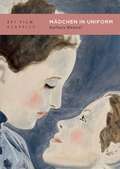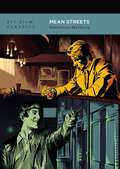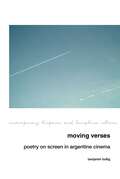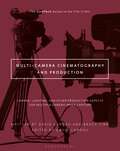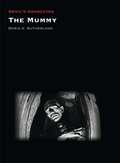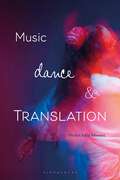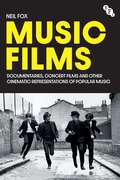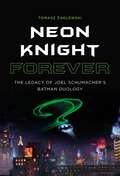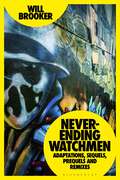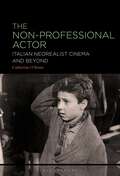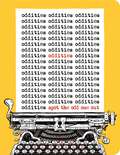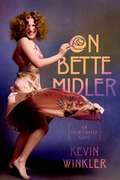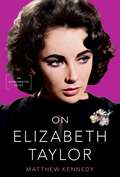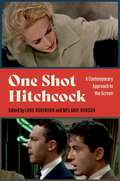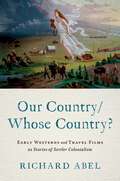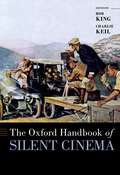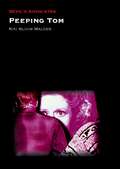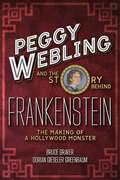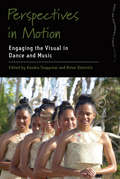- Table View
- List View
Mädchen in Uniform (BFI Film Classics)
by Barbara MennelLeontine Sagan's Mädchen in Uniform (1931) is a groundbreaking German film that showcases women's agency and desire behind and in front of the camera.Adapted from Christa Winsloe's lesbian play, the story follows Manuela, an orphan in a boarding school for impoverished Prussian nobility. When she declares her love with her female teacher, the oppressive principal punishes her, leading to a desperate suicide attempt.Barbara Mennel's compelling study firmly establishes Mädchen in the Weimar cinema canon. Mennel contextualises the film in 1920s theories of sexuality and the conventions of modernist cinema. She contrasts its international success to the extensive censorship battles that surrounded it. The film's unique transnational and fragmented history results from the exile of many of its makers during the Nazi regime. By attending to the many remakes throughout the 20th and 21st century, Mennel underscores the film's timeless impact that continues to resonate with contemporary audiences.
The Masque of the Red Death (Devil's Advocates)
by Steve HabermanThe Masque of the Red Death (1964), the seventh collaboration between producer-director Roger Corman and horror icon Vincent Price, became the crowning achievement for both men, their masterpiece. After the critical and commercial success of House of Usher in 1960, Corman fervently desired to adapt Edgar Allan Poe’s story, ‘The Masque of the Red Death’ as his next project, but the tale took three years to finally become, not Corman’s second Poe film, but his second to last. Its long development benefitted the end result, and the story of its making reveals the persistence and vision of Corman, the artist and entrepreneur of classic horror. In this Devil’s Advocate, Steve Haberman takes an auteurist approach to the film with Corman as the ultimate author of the work. He explores the emergence of Corman’s themes and techniques through directorial control and compares them with the intentions and concerns of the story’s original creator, Poe. In his research, Haberman secured both drafts of the script, the first by Charles Beaumont and the last by R. Wright Campbell, consulted published interviews and met with Corman. The result illuminates not only the film but the profound and profoundly dark world views of both Roger Corman and Edgar Allan Poe.
Mean Streets (BFI Film Classics)
by Demetrios MatheouMean Streets was Martin Scorsese's third feature film, and the one that confirmed him as a major new talent. On its premiere at the New York Film Festival in 1973, the critic Pauline Kael hailed the film as 'a true original of our period, a triumph of personal film-making'. The tale of combative friends and small-time crooks is set amid the bars, pool halls, tenements and streets of Manhattan's Little Italy. Scorsese has said of his childhood neighbourhood, 'its very texture was interwoven with organised crime', and this quality would dramatically inform the tone and restless energy of his seminal film.Demetrios Matheou's insightful study considers Mean Streets' production history in the context of the New Hollywood period of American cinema, noting also the key roles played by John Cassavetes and Roger Corman. He analyses the importance of Scorsese's background to the film's characters and themes, including preoccupations with guilt, redemption and criminal subcultures; the development of the director's film-making process and signature style; the way in which he both drew upon and invigorated the crime genre; his relationship with emerging stars Robert De Niro and Harvey Keitel, and the film's reception and legacy. Matheou argues that while Taxi Driver (1976) and Raging Bull (1980) are regarded as Scorsese's greatest films of the period, Mean Streets is the more influential achievement. With it, Scorsese not only paved the way for a new kind of crime movie, not least his own GoodFellas (1990), but also inspired generations of independently-minded film-makers.
Moving Verses: Poetry on Screen in Argentine Cinema (Contemporary Hispanic and Lusophone Cultures #24)
by Ben BolligFrom Wild Tales to Zama, Argentine cinema has produced some of the most visually striking and critically lauded films of the 2000s. Argentina also boasts some of the most exciting contemporary poetry in the Spanish language. What happens when its film and poetry meet on screen? Moving Verses studies the relationship between poetry and cinema in Argentina. Although both the “poetics of cinema” and literary adaptation have become established areas of film scholarship in recent years, the diverse modes of exchange between poetry and cinema have received little critical attention. The book analyses how film and poetry transform each another, and how these two expressive media behave when placed into dialogue. Going beyond theories of adaptation, and engaging critically with concepts around intermediality and interdisciplinarity, Moving Verses offers tools and methods for studying both experimental and mainstream film from Latin America and beyond. The corpus includes some of Argentina’s most exciting and radical contemporary directors (Raúl Perrone, Gustavo Fontán) as well as established modern masters (María Luisa Bemberg, Eliseo Subiela), and seldom studied experimental projects (Narcisa Hirsch, Claudio Caldini). The critical approach draws on recent works on intermediality and “impure” cinema to sketch and assess the many and varied ways in which directors “read” poetry on screen.
Multi-Camera Cinematography and Production: Camera, Lighting, and Other Production Aspects for Multiple Camera Image Capture (The CineTech Guides to the Film Crafts)
by David Landau Bruce FinnA how-to book on the art, craft and practice of TV/video/streaming cinematography for multi-camera shooting.This book is written for anyone wanting to film, direct or produce multiple camera productions. Lighting Directors, Directors of Photography, Camera Operators as well as Directors, Producers and Production Managers will all find valuable information that will help them do their job and accomplish their goals of effectively filming with more than one camera at the same time. This book could be seen as an intermediate to advanced media production course book for colleges. It is also meant to give insight and inspiration to those starting out their professional careers in multi-camera productions. The text covers advice for producing and filming content using two or more cameras in many genres including Sitcom, Stand-up, News, Talk Show, Interview, Reality, Corporate Video and Indie Movies, with budgets both big and small, by two award winning professional industry cinematographers/lighting directors with over 30 years of experience each.
The Mummy (Devil's Advocates)
by Doris SutherlandReleased in 1932, The Mummy moved Universal horror away from the Gothic Europe of Dracula and Frankenstein and into a land of deserts, pyramids, and long-lost tombs. In doing so the film continued a tradition of horror fiction that is almost as old as the Western pursuit of Egyptology, as numerous European and American authors from the nineteenth and early twentieth centuries had portrayed Egypt as a place of mystery and magic. This book examines the roots of The Mummy. It shows how the film shares many of its motifs with the work of writers such as Bram Stoker, Arthur Conan Doyle, and H. Rider Haggard, whose tales of living mummies, immortal sorcerers, and Egyptian mysticism bear strong resemblances to Universal’s movie. In addition, the book discusses how The Mummy drew upon a contemporary vogue for all things ancient Egyptian: the tomb of Tutankhamun was discovered the decade before the film was released, prompting sensationalistic rumors of a curse. This is the story of what happened when Hollywood horror went to Egypt.
Music, Dance and Translation
How is music affected by its translation, interpretation and adaptation with, through, and by dance? How might notation of dance and music act as a form of translation? How does music influence the creation of dance? How might dance and music be understood to exchange and transfer their content, sense and process during both the creative process and the interpretative process? Bringing together chapters that explore theory and practice, this book questions the process and role translation has to play in the context of music and dance. It provides a range of case studies across this interdisciplinary field, and is not restricted by genre, style or cultural location. As one of very few volumes to explore translation in relation to music and to overtly tackle this topic in terms of dance, it moves the argument from a broad notion of text and translation, to think critically about the sound and movement arts of music and dance, using translation as a model to better understand the collaboration of these art forms.
Music Films: Documentaries, Concert Films and Other Cinematic Representations of Popular Music
by Neil FoxIn Music Films, Neil Fox considers a broad range of music documentaries, delving into their cinematic style, political undertones, racial dynamics, and gender representations, in order to assess their role in the cultivation of myth.Combining historical and critical analyses, and drawing on film and music criticism, Fox examines renowned music films such as A Hard Day's Night (1964), Dig! (2004), and Amazing Grace (2006), critically lauded works like Milford Graves Full Mantis (2018) and Mistaken for Strangers (2013), and lesser-studied films including Jazz on a Summer's Day (1959) and Ornette: Made in America (1985). In doing so, he offers a comprehensive overview of the genre, situating these films within their wider cultural contexts and highlighting their formal and thematic innovations.Discussions in the book span topics from concert filmmaking to music production, the music industry, touring, and filmic representations of authenticity and truth. Overall, Music Films traces the evolution of the genre, highlighting its cultural significance and connection to broader societal phenomena.
Neon Knight Forever: The Legacy of Joel Schumacher’s Batman Duology
by Tomasz ZaglewskiNeon Knight Forever is a detailed study of one of the most misunderstood superhero series that dares to ask the most heretical question for all Bat-fans: what if Batman & Robin is actually a valuable achievement in big-budget superhero cinema? The Batman franchise has remained one of the most lucrative and varied lines of superhero-based titles outside its original comic book, with adaptations from filmmakers such as Christopher Nolan, Tim Burton, and Zack Snyder. However, among the many facets of Batman, there is one which remains on the margins of Bat-history, being treated as the most obscure or misconceived: the Batman duology directed by Joel Schumacher between 1995 and 1997, a creation which is seen by many fans as the "wrong" approach to the Batman mythos. Neon Knight Forever accounts for the initial rejection of Schumacher's version and explores modern attempts to rehabilitate Schumacher's vision of the infamous Neon Knight. Through discussing the formal foundations underlying both Batman Forever and Batman & Robin and featuring claims from the Schumacher online fandom, Zaglewski embraces the adaptation as a valuable addition to the Batman universe.
Never-Ending Watchmen: Adaptations, Sequels, Prequels and Remixes
by Will BrookerWhat began with Alan Moore and Dave Gibbons' landmark graphic novel, Watchmen (1987) is no longer a single story, but rather a cross-platform, multi-media franchise, including a role-playing game and video game, a motion comic, a Zack Snyder movie, and a series of comic book prequels and sequels, as well as a prestige HBO TV series. Will Brooker explores the way that Watchmen expanded over time from the mid-1980s to the present day, drawing on theories of adaptation, intertextuality and deconstruction to argue that each addition subtly changes our understanding of the original. Does it matter whether these adaptations are 'faithful'? Can they ever be, as they cross over into another medium? How does each version enter a dialogue with the others? And as Damon Lindelof's series ran parallel to an entirely distinct comic book Watchmen sequel, Doomsday Clock, how do readers and viewers make sense of these conflicting narratives? Can we relate the unstable, shifting stories of Watchmen to our contemporary climate of post-truth, where we have to weigh up contradictory versions of the facts and decide which we believe?
No Joke: Todd Phillips's Joker and American Culture
by M. BookerNo Joke is a detailed examination of Todd Phillips’s Joker, one of the biggest global box-office hits of 2019. While his success was no doubt partly because of the association of its title character with the Batman superhero franchise, Joker is anything but a flashy superhero romp. It does explore the pathologies of its central character and suggest ways in which his life experiences might have driven him to become a supervillain, the arch-enemy of Batman. At the same time, the film leaves open the possibility that its “Joker” is not, in fact, the same as the one conventionally associated with Batman. In fact, the film leaves open many interpretive possibilities, in keeping with the complex work of postmodern art that it turns out to be. Joker also engages in extensive dialogues with a range of works from modern American culture, especially the films of the 1970s and 1980s, the period in which the action of Joker is set. Moreover, Joker is a highly political film that comments in important ways on American political history from roughly the beginning of the presidency of Richard Nixon through the end of the Trump presidency, with a special focus on the Reagan years. It also comments in more general and fundamental ways on the very nature of American society and American capitalism. All this, and more, is covered in M. Keith Booker’s analysis of one of the most talked-about films of recent years.
The Non-Professional Actor: Italian Neorealist Cinema and Beyond
by Dr. Catherine O'RaweProvides the first critical overview of acting, stardom, and performance in post-war Italian film (1945-54), with special attention to the figure of the non-professional actor, who looms large in neorealist filmmaking. Italian post-war cinema has been widely celebrated by critics and scholars: films such as Bicycle Thieves (De Sica, 1948) and Paisan (Rossellini, 1946) remain globally influential, particularly for their use of non-professional actors. This period of regeneration of Italian cinema initiated the boom in cinemagoing that made cinema an important vector of national and gender identity for audiences.The book addresses the casting, performance, and labour of non-professional actors, particularly children, their cultural and economic value to cinema, and how their use brought ideas of the ordinary into the discourse of stars as extraordinary. Relatedly, O'Rawe discusses critical and press discourses around acting, performance, and stardom, often focused on the 'crisis' of acting connected to the rise of non-professionals and the girls (like Sophia Loren) who found sudden cinematic fame via beauty contests.
Nosferatu in the 21st Century: A Critical Study
‘Nosferatu’ in the 21st Century is a celebration and a critical study of F. W. Murnau’s seminal vampire film Nosferatu, eine Symphonie des Grauens on the 100th anniversary of its release in 1922. The movie remains a dark mirror to the troubled world we live in seeing it as striking and important in the 2020s as it was a century ago. The unmistakable image of Count Orlok has traveled from his dilapidated castle in old world Transylvania into the futuristic depths of outerspace in Star Trek and beyond as the all-consuming shadow of the vampire spreads ever wider throughout contemporary popular culture. This innovative collection of essays, with a foreword by renowned Dracula expert Gary D. Rhodes, brings together experts in the field alongside creative artists to explore the ongoing impact of Murnau’s groundbreaking movie as it has been adapted, reinterpreted, and recreated across multiple mediums from theatre, performance and film, to gaming, music and even drag. As such, ‘Nosferatu’ in the 21st Century is not only a timely and essential book about Murnau’s film but also illuminates the times that produced it and the world it continues to influence.
Oddities: Spot the Odd One Out
by John BigwoodLife’s odd, isn’t it? People are odd, places are odd, things are odd. It’s an odd old world. There’s oddity in the strangest places, not least in this extreme odd-one-out challenge.From a perfectly groomed, flowery beard and a trendy cycling cap, to a prickly cactus and a delicious flat white, discover the minute differences lurking on every page. There are odd ones out to spot, hipster accessories to match, and much more millennial fun to be had.Cool and quirky black and white illustrations are accompanied by funny one liners and utterly useless, and odd, trivia. It’s time to find the oddest of odd ones out.
The Omen (Devil's Advocates)
by Adrian SchoberDirected by Richard Donner and written by David Seltzer, The Omen (1976) is perhaps the best in the devil-child cycle of movies that followed in the wake of Rosemary’s Baby and The Exorcist. Released to a highly suggestible public, The Omen became a major commercial success, in no small part due to an elaborate pre-sell campaign that played and preyed on apocalyptic fears and a renewed belief in the Devil and the supernatural. Since polarising critics and religious groups upon its release, The Omen has earned its place in the horror film canon. It’s a film that works on different levels, is imbued with nuance, ambiguity and subtext, and is open to opposing interpretations. Reflecting the film’s cultural impact and legacy, the name ‘Damien’ has since become a pop culture byword for an evil child. Adrian Schober’s Devil’s Advocate entry covers the genesis, authorship, production history, marketing and reception of The Omen, before going on to examine the overarching theme of paranoia that drives the narrative: paranoia about the 'end times'; paranoia about government and conspiracy; paranoia about child rearing (especially, if one strips away the layer of Satanism); and paranoia about imagined threats to the right-wing Establishment from liberal and post-countercultural forces of the 1970s.
On Bette Midler: An Opinionated Guide
by Kevin WinklerBette Midler today is a beloved legacy star, best known for her comic witch in Disney's Hocus Pocus (1993) and its 2022 sequel. She has also gained prominence for sentimental, anthemic ballads like "Wind Beneath My Wings," her initiation of green space projects in New York City, and tussling with Donald Trump on Twitter. Her profile is that of an articulate, civic-minded matriarch enjoying thoroughly mainstream stardom. But more than fifty years earlier she emerged from the steam of the subterranean Continental Baths as the Divine Miss M, the bawdy, campy, fearless alter ego she created in front of an audience of towel-clad gay men who came to the baths seeking not just sex, but a sense of community and safety from an often-harrowing outside world. "I was able to take chances on that stage that I could not have taken anywhere else," she later wrote. "Ironically, I was freed from fear by people who, at the time, were ruled by fear. And for that I will always be grateful." Overnight, Bette Midler became a much-loved icon of the gay community. The Divine Miss M coalesced gay, Jewish, feminist, and show business sensibilities into an outrageously funny and emotionally compelling persona that travelled with surprising ease from the cultural margins to the entertainment mainstream. Her embrace by mom-and-pop audiences, rock fans and critics, and the guardians of middle-of-the-road show business demonstrates just how deeply the tastes and sensibilities of her original audience have been absorbed into popular culture. On Bette Midler: An Opinionated Guide traces the early development of Midler's performing ethos from New York's downtown experimental theater scene and examines her impact across media, with chapters on the soaring highs (and occasional cringe-worthy lows) of her stage work, movies, recordings, and television appearances, and considers her influence as an environmental activist and social media presence. On Bette Midler features performance analysis and deeply researched background information, all of it supporting informed--and divinely opinionated--consideration of Midler the artist. It judges her work by the highest standards: those she established for herself.
On Elizabeth Taylor: An Opinionated Guide
by Matthew KennedyA sweeping look at the career of a truly singular Hollywood star In the oceans of ink devoted to the monumental movie star/businesswoman/political activist Elizabeth Rosemond Taylor (1932-2011), her beauty and not-so-private life frequently overshadowed her movies. While she knew how to generate publicity like no other, her personal life is set aside in this volume in favor of her professional oeuvre and unique screen dynamism. In On Elizabeth Taylor: An Opinionated Guide, her marriages, illnesses, media firestorms, perfume empire, violet eyes, and AIDS advocacy take a back seat to Elizabeth Taylor, the actress. Taylor's big screen credits span over fifty years, from her pre-adolescent debut in There's One Born Every Minute (1942) to her cameo in The Flintstones (1994). She worked steadily in everything from the biggest production in film history (Cleopatra in 1963) to a humble daytime TV soap opera (General Hospital in 1981). Each of her sixty-seven film appearances is recapped here with background on their inception, production, release, and critical and financial outcome. On Elizabeth Taylor: An Opinionated Guide is a cradle-to-grave chronology of Taylor's life, noting key events, achievements, and milestones. This book offers a work-by-work analysis of her entire career told in chronological order, each film headlined with year of release, distributing studio, and director. This in-depth overview provides an invaluable new way of understanding Taylor's full life and work, as well as the history and nuances of the film industry as it existed in the twentieth century. Kennedy engagingly reassesses Taylor's acting and the nuances she brought to the screen - this includes a consideration of her specific art, the development of her voice, her relationship to the camera, and her canny understanding of the effect she had on audiences worldwide. Kennedy also provides an elucidating guide to her entire filmography, one that speaks to the quality of her performances, their contours and shading, and their context within her extraordinary life and career. On Elizabeth Taylor is a beautifully comprehensive overview of a singular actress of the twentieth century, offering new ways to see and appreciate her skill and peerless charisma, in turn placing her among the greatest film stars of all time.
One Shot Hitchcock: A Contemporary Approach to the Screen
In recent years, the enduring appeal of Alfred Hitchcock to film studies has been evidenced by the proliferation of innovative approaches to the director's work. Adding to this pattern of innovation, the edited collection One Shot Hitchcock: A Contemporary Approach to the Screen utilizes formal analysis to interrogate key single shots from across Alfred Hitchcock's long career. This collection reveals the value of analyzing the single shot - within this small, cinematic unit is a code that unlocks a series of revelations about cinema as an artistic practice and a theoretical study. Each chapter examines one shot from a single film, beginning with The Lodger (1927) and ending with Frenzy (1972). If Hitchcock is known as a director of suspense films and films about murder, the shots discussed in One Shot Hitchcock are his crime scenes. These are the shots that resist being forgotten, that repeatedly demand to be investigated, in which Hitchcock's influence on aesthetics and culture is at its most acute. Each chapter uses a different lens of film analysis - transnationalism, gender and sexuality, performance, history, affect, intermediality, remake studies, philosophy, and film form are all used to interrogate single shots. In these essays, the single shot from Hitchcock's film not only illustrates the approach in question but also demonstrates how the single shot encourages us to rethink our approaches to the screen. By reinvigorating a close formal mode of analysis, One Shot Hitchcock asks readers to think differently about film, offering a renewed assessment of Hitchcock's oeuvre in the process.
Our Country/Whose Country?: Early Westerns and Travel Films as Stories of Settler Colonialism
by Richard AbelThe concept of settler colonialism offers an invaluable lens to reframe early westerns and travel pictures as re-enactments of the United States' repressed past. Westerns in particular propose a remarkable vision of white settlers' westward expansion that reveals a transformation in what "American Progress" came to mean. Initially, these films tracked settlers moving westward across the Appalachians, Great Plains, and Rockies. Their seizure of "empty land" provoked continual resistance from Indigenous peoples and Mexicans; "pioneers" suffered extreme hardships, but heroic male figures usually scattered or wiped out those "aliens." Some films indulged in nostalgic empathy for the Indian as a "Vanishing American." In the early 1910s, westerns became increasingly popular. In Indian pictures, Native Americans ranged from devious savages, victims of white violence, and "Noble Savages" to "in-between" figures caught between cultures and "mixed-descent peoples" partnered for security or advantage. Mexicans took positions across a similar spectrum. In cowboy and cowgirl films, "ordinary" whites became heroes and heroines fighting outlaws; and bandits like Broncho Billy underwent transformation into "good badmen." The mid to late 1910s saw a shift, as Indian pictures and cowgirl films faded and male figures, embodied by movie stars, dominated popular series. In different ways, William S. Hart and Harry Carey reinvented the "good badman" as a stoic, if troubled, figure of white masculinity. In cowboy films of comic romance, Tom Mix engaged in dangerous stunts and donned costumes that made him a fashionable icon. In parodies, Douglas Fairbanks subverted the myth of "American Progress," sporting a nonchalant grin of effortless self-confidence. Nearly all of their films assumed firmly settled white communities, rarely threatened by Indians or Mexicans. Masked as "Manifest Destiny," the expropriation of the West seemed settled once and for all. Our Country/Whose Country? offers a rich and expansive examination of the significance of early westerns and travel pictures in the ideological foundations of "our country."
The Oxford Handbook of Radio and Podcasting (Oxford Handbooks)
Radio today remains the most accessible and widely available communication medium worldwide, despite technological shifts and a host of upstart challengers. Since its origins in the 1920s, radio has innovated a new world of sound culture - now expanded into the digital realm of podcasting that is enabling the medium to reach larger audiences than ever before. Yet radio remains one of the least studied of the major areas of communication arts, due largely to its broadcast-era ephemerality. With the advent of digital technology, radio's past has been unlocked and soundwork is exploding as a creative field, creating a lively and diverse sonic present while simultaneously making critical historical analysis possible at last. This volume offers newly commissioned chapters giving readers a wide-ranging view of current critical work in the fields of radio and podcasting, employing specific case studies to analyze sound media's engagement with the arts; with the factual world of news, talk, and documentary programming; as a primary means of forging community along with national, transnational, and alternative identities; and as a subject of academic and critical research. Its historical scope extends from radio's earliest days, through its mid-twentieth century decades as the powerful voice of nations and empires, onto its transformation into a secondary medium during the television era, and into the expanding digital present. Over the course of 37 chapters, it provides evidence of the sound media's flexibility and adaptation across diverse cultures by examining radio's past and present uses in regions including the United States, Canada, Britain, Australia, Poland, China, Korea, Kenya, Angola and Mozambique, South Asia, and the Caribbean. Contributors include historians and media scholars as well as sound artists and radio/podcast producers. Notably, companion links to digital ?quotations? from works analyzed are included in many chapters along with chapter audiographies offering links to further listening. Throughout, The Oxford Handbook of Radio and Podcasting connects radio's broadcast past to its digital present, and traces themes of creativity, identity, community, nation, and transnationality across more than a century of audio media.
The Oxford Handbook of Silent Cinema (Oxford Handbooks)
With thirty-four original chapters from three dozen top scholars, The Oxford Handbook of Silent Cinema provides a thoughtful and provocative re-examination of a medium that would become the dominant form of mass entertainment by the second decade of the twentieth century. The volume is arranged around a series of broad topics: the "invention" of cinema as both technology and medium; the intermedial development of film aesthetics and genres; nontheatrical and non-commercial uses of cinema; the political economy of Hollywood mass culture; film and global modernities; and silent cinema's publics and counter-publics. The historiographical essays in this collection engage with the question of how we might rethink silent film history, especially in the context of the developed media ecosystem that defined the early 1900s. Influenced by methodologies as diverse as media archaeology and industrial studies, and sensitive to both the textual contours of silent films and the cultural, economic, and ideological currents that helped shape them, the Oxford Handbook of Silent Cinema invites its reader to envision its object in expansive terms that incorporate the propulsive energy of the first decades of the 1900s and deploy the analytical frameworks of the current day.
Peeping Tom (Devil's Advocates)
by Kiri WaldenReviled on its release, Peeping Tom (1960) all-but ended the career of director Michael Powell, previously one of Britain's most revered filmmakers. The story of a murderous cameraman and his compulsion to record his killings, Powell's film stunned the same critics who had acclaimed him for the work he'd made with writer-producer Emeric Pressburger (The Life and Death of Colonel Blimp, 1943; A Matter of Life and Death, 1946), resulting in the film falling out of circulation almost as soon as it was released. It took the 1970s 'Movie Brat' generation to rehabilitate the director, and the film, which is now regarded as a masterpiece. In this Devil's Advocate, published to coincide with the film's 60th anniversary, Kiri Walden charts the origins, production and devastating critical reception of Peeping Tom, comparing it to the treatment meted out to its contemporary horror classic, Alfred Hitchcock's Psycho (1960).
Peggy Webling and the Story behind Frankenstein: The Making of a Hollywood Monster
by Peggy Webling Dorian Gieseler Greenbaum Professor Bruce GraverThe 1931 Universal Pictures film adaptation of Frankenstein directed by James Whale and starring Boris Karloff as the now iconic Monster claims in its credits to be 'Adapted from the play by Peggy Webling'. Webling's play sought to humanize the creature, was the first stage adaptation to position Frankenstein and his creation as doppelgängers, and offered a feminist perspective on scientific efforts to create life without women, ideas that suffuse today's perceptions of Frankenstein's monster. The original play script exists in several different versions, only two of which have ever been consulted by scholars; no version has ever been published. Nor have scholars had access to Webling's private papers and correspondence, preserved in a family archive, so that the evolution of Frankenstein from book to stage to screen has never been fully charted. In Peggy Webling and the Story behind Frankenstein, Dorian Gieseler Greenbaum (Webling's great grandniece) and Bruce Graver present the full texts of Webling's unpublished play for the first time. A vital critical edition, this book includes: - the 1927 British Library Frankenstein script used for the first production of the play in Preston, Lancashire - the 1928 Frankenstein script in the Library of Congress, used for productions in UK provincial theatres from autumn 1928 till 1930 - the 1930 Frankenstein Prompt Script for the London production and later provincial performances, held by the Westminster Archive, London - Webling's private correspondence including negotiations with theatre managers and Universal Pictures, family letters about the writing and production process, and selected contracts - Text of the chapter 'Frankenstein' from Webling's unpublished literary memoir, The Story of a Pen for additional context - Biography of Webling that bears directly on the sensibilities and skills she brought to the writing of her play - History of how the play came to be written and produced - The relationship of Webling's play to earlier stage and film adaptations - An exploration of playwright and screenwriter John L. Balderston's changes to Webling's play and Whale's borrowings from it in the 1931 film Offering a new perspective on the genesis of the Frankenstein movie, this critical exploration makes available a unique and necessary 'missing link' in the novel's otherwise well-documented transmedia cultural history.
Perspectives in Motion: Engaging the Visual in Dance and Music (Dance and Performance Studies #15)
by Kendra Stepputat Brian DiettrichFocusing on visual approaches to performance in global cultural contexts, Perspectives in Motion explores the work of Adrienne L. Kaeppler, a pioneering researcher who has made a number of interdisciplinary contributions over five decades to dance and performance studies. Through a diverse range of case studies from Oceania, Asia, and Europe, and interdisciplinary approaches, this edited collection offers new critical and ethnographic frameworks for understanding and experiencing practices of music and dance across the globe.
Pet Sematary (Devil's Advocates)
by Shellie McMurdoMost scholarship on Mary Lambert's Pet Sematary (1989) overarchingly focuses on the Stephen King novel (1983), and tends strongly towards housing the story within the Gothic literary tradition. The film itself is often absent from considerations of North American horror cinema of the 1980s, and from wider horror scholarship in general. This Devil's Advocate stands as a corrective, and provides a holistic analysis – textual, contextual, and industrial – of the film, in order to properly situate it as an important entry into the history of horror cinema. This book joins a growing body of works – both journalistic and academic – that aim to revisit older films in order to call attention to and/or redress the gendered imbalance in our written horror histories. McMurdo charges Pet Sematary with several contributions to the horror genre: as an important entry within the tradition of “grief horror”; as a horror film that both adheres to and defies the generic conventions of its historical context, one both engaged with and respondent to its time of creation; as a film that changed the fortunes of the cinematic Stephen King “brand” on the cusp of a new decade. Pet Sematary is the highest grossing horror film directed by a woman in cinematic history, and it stands as a story that we keep returning to – as seen by the 1992 sequel, the 2019 remake, and a forthcoming prequel. Pet Sematary’s modern relevance and importance to genre history then, is manifold, and this book argues it is past time for its reconsideration as a classic of horror cinema.
